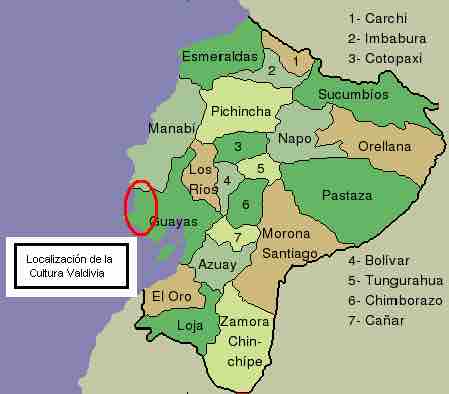The Valdivia culture is one of the oldest settled cultures recorded in the Americas. It emerged from the earlier Las Vegas culture, and thrived on the Santa Elena peninsula near the modern-day town of Valdivia, Ecuador, between 3500-1800 BCE.

Map of Valdivian Culture
Shown here is the location of the Valdivia culture.
Life Among the Valdivians
The Valdivia lived in a community that built its houses in a circle or oval around a central plaza. They were sedentary, egalitarian people who lived off farming and fishing, and occasional deer hunting. From the remains that have been found, it has been determined that Valdivians cultivated maize, kidney beans, squash, cassava, chili peppers, and cotton plants, the latter of which was used to make clothing.
Pottery
Valdivian pottery, which has been dated to 2700 BCE, was initially rough and practical, but over time became splendid, delicate, and large. Bowls, jars, and female statues were used in daily life and religious ceremonies. They generally used the colors red and gray, and polished dark red pottery is characteristic of the Valdivia period. In their ceramics and stone works, the Valdivia culture showed a progression from the most simple, to much more complicated works. Valdivians were the first Americans to use pottery.
Valdivian Pottery
Valdivian pottery is the oldest in America, on display in this image at the Museo de La Plata in Argentina.
The trademark Valdivia pottery piece is the "Venus" of Valdivia: feminine ceramic figures. The "Venus" of Valdivia likely represented actual people; each figurine is individual and unique, as can be seen in the hairstyles. They were made by joining two rolls of clay, leaving the lower portion separated as legs and forming the body and head from the top portion. The arms were usually very short, and in most cases were bent towards the chest, holding the breasts or chin.
Trade
Valdivians created rafts with sails, and built a maritime trade network with tribes in the Andes and Amazon. A main trading item was the red shell of the thorny oyster, called Spondylus, which were often made into ornaments, and were considered more valuable than gold or silver.